We made it to Alaska! 18 days. 650 nautical miles. 195 of that motoring and 455 sailing (70%). We stepped off the boat only once, for fuel in Port McNeill. It was the most challenging trip we’ve ever done, made more challenging due to thru-transiting restrictions and the early season. We had sun, rain, snow, graupel storms, high winds, and at times rough seas. The early season meant we usually had plenty of wind, enabling us to sail fast and minimize motoring. Though we had some very tough days, our past years of experience along three-quarters of the route helped a lot.

We were allowed into Canada as a marine thru-transit because we were moving our home to Alaska for residency, and were not allowed to get off the boat or sightsee. We anchored each night to rest (and because it’s unsafe to travel the Inside Passage at night with the hundreds of logs/trees we had to dodge). And we were allowed to stop for fuel, water, or groceries which we did once for only fuel and water. We also were told to get through as quickly as possible – the Canadian customs main priority seemed to be ensuring that no tourism happens.
Needless to say there was no tourism, as we were already motivated to go as quickly as possible. We were dead tired each night and spent our days in transit or fixing issues on the boat.
It’s about 600-700 nautical miles to Alaska from Friday Harbor (where we started in the San Juans) but this distance is deceptive – it feels much longer than that because there are dozens of different weather systems, tidal gates, and sailing challenges to go through. Every day is different, and the wind comes from all directions. One day you might have a southeast gale followed by a northwest gale the next day (as happened around Campbell River).
Going to Alaska this quickly is not what we’d call fun. It was one challenging passage after another, with no break in between and none of the typical rewards of cruising (visiting ports, hiking on shore, water activities like paddleboarding, crabbing / fishing, etc).

A small graupel shower while sailing up Petrel Channel
Stats
- Route measured from Roche Harbor (San Juans) to Foggy Bay, AK
- Distance traveled: 652 nautical miles (measured by speed thruhull transducer)
- Motored: 195 nm
- Sailed: 457 nm
- Hours motored: 39.8
- Fuel used: Approx 18 gallons + 2-3 for diesel heater
- Longest day: 67 nm
- Water used: Approx 50 gallons
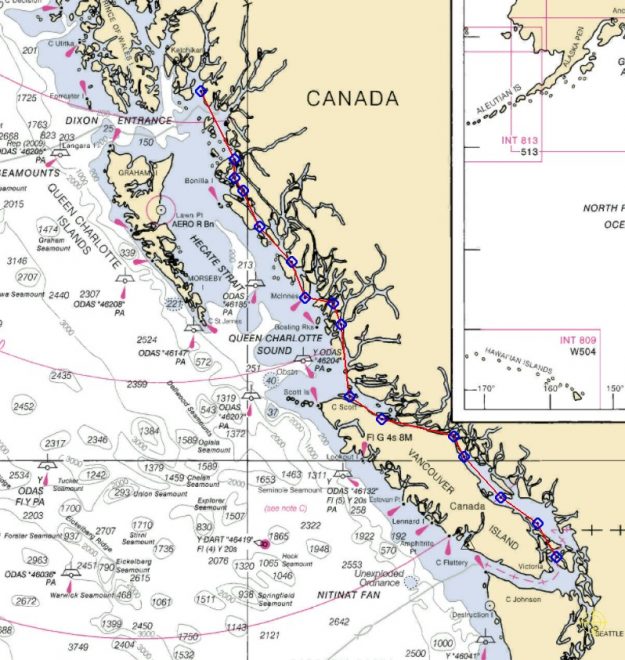
Schedule
We estimated it would take us 2-4 weeks to get to AK, but the CBSA wanted us to do it in 2 weeks (with possible extension if needed). 2 weeks is very fast for a slow sailboat in even ideal conditions like June, July or August. March and April are nothing like those summer-time conditions. And while 2 weeks is no problem for a speedboat or even a “slow” motorboat, those “slow” motorboats are very fast boats compared to us (they can typically go 7-10 kts, 25-50% faster than our typical speed).
We went as fast as possible, which meant some very long, tiring days. We often woke up before dawn, made coffees and breakfast, stowed everything in the cabin for rough seas, and started hauling anchor at first light. Then when we arrived at anchor there was often something to fix – things break, loosen, or vibrate apart when you’re pushing a cruising boat hard.
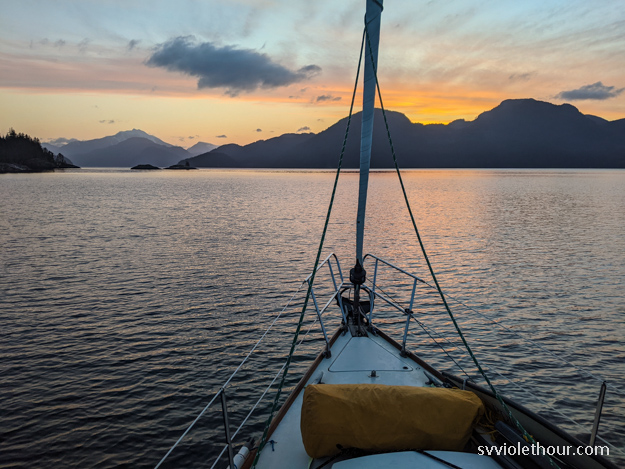
Departing Otter Cove (Discovery Passage / Johnstone Strait) near sunrise to catch ebb tide in Johnstone Strait.
Weather
The weather overall was typical unsettled spring weather – wind nearly every day, some sun, some rain, chilly mornings and nights. But the first week was distinctly different – up to Johnstone and Port McNeill we had pretty nice, mostly sunny weather with warm days, just a little rain.
Once we got north of Cape Caution, to the Central Coast and North Coast, things got much colder – it was still winter up there! We had a snow storm while motoring towards Shearwater. Graupel squalls (pelletized hail) pummeled our cockpit enclosure in Principe Channel, and again every day for the next 5 days. In the mornings we woke up to a freezing cold cabin with our breathe visible in the air, iced up cockpit enclosure and frosty decks. We had rain, graupel or snow pretty much every day, and the boat interior started to get very wet and drippy.

2 inches of graupel fell overnight, waking us with the sound of pounding hail on deck.
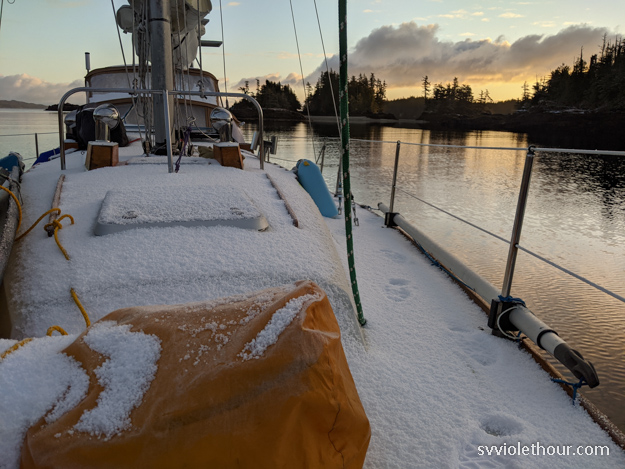
We knew it would be cold sailing to Alaska in late March thru early April but this is the point where we realized maybe we’d gone a little too early. This was my fault – I was impatient from waiting an entire year on our planned sail north, and the warm spring weather in the San Juans in March (shorts + t-shirt weather at times!) lulled me into a sense that we were firmly on the path to a pleasant spring. On the other hand, the plus side of leaving early was we had plenty of wind for sailing!
Wind & Sailing
Wind is generally plentiful in the spring, and this makes it a great time for sailing (really sailing, not motoring) the Inside Passage. This has always been the key part of our strategy in past years. This time it was extra challenging though because we felt we were on a schedule, and this can make things dangerous – going against a gale in some areas is not a smart move.
So we had to be very tactical, studying weather forecasts daily in great detail, and understanding our limits / capabilities. When we got a southerly we would run as fast and far as we could under sail. We had double reefed sails quite often because at times we were running in 30 knots. When northerlies arrived we’d bash to windward or motor when it was light.
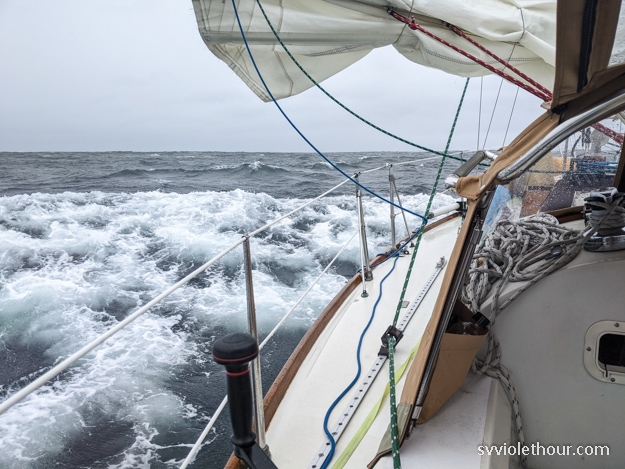
Downwind in SE 20-25 later building to SE 30, rounding Cape Caution into Fitz Hugh Sound. Double reefed main, double to triple reefed genoa, sailing at 7 kts.
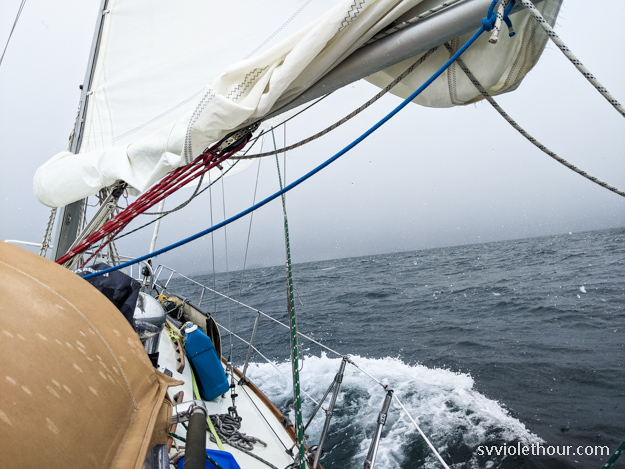
Sailing into a snow squall where we had an unexpected 30 kts (upwind!), very poor visibility, and awful wave state (later) in Chatham Sound.
We took the “outer” route on the North Coast because it’s the best sailing route – going around Price Island, up Laredo Sound/Channel and then up Principe Channel, Petrel Channel and Chatham Sound. Some call this the outer-inner route (a better way to put it) because it’s not all the way out in Hecate, but it’s not the inner route (motorboat route) which is Grenville Channel + Princess Royal.
Boat Issues / Maintenance
When you’re pushing a sailboat hard on a 3-week passage, some stuff inevitably breaks. If you’re heading to Alaska, perhaps this will help give you some idea of what issues may be most common. Some of these things were just regular maintenance and some things were due to minor mistakes we made:
- Tore the mainsail (fixed with patch). It’s old.
- Ripped a dorade off the cabin when genoa sheet caught it. Ouch.
- Broke 2 sail track slides (sail slugs).
- Engine:
- Exhaust elbow smoking – I had replaced the exhaust elbow / dry exhaust coupler in February and it appeared to be leaking exhaust. In retrospect it may have just been the thread lubricant burning off. I resealed it and then had more white smoke for 8-10 hours, which I now think was the excess thread sealant smoking off.
- Fuel filter restricted, engine rpm variable and power loss – replaced primary Racor filter. Our fuel tank got shaken up thoroughly in the Strait of Georgia, Johnstone, and Cape Caution.
- Minor coolant leak – tightened hose clamp.
- Raw water leak – tightened hose clamp. (these may have loosened up in the heavy seas we were rolling in)
- Topped up engine oil.
- Shaft lock repair / improvements.
Some of the engine maintenance could’ve been avoided by doing more of a shakedown cruise before heading north. I did a lot of engine work over the winter, which had it running super well but we only did a couple short motoring jaunts in the San Juans after all the work. Motoring for 8-10 hours and tossing the boat in heavy tide rips in a near-gale would’ve revealed the issues found while northbound. But who wants to do that for fun?! Fortunately having plenty of spares onboard meant I could fix nearly any problem underway.
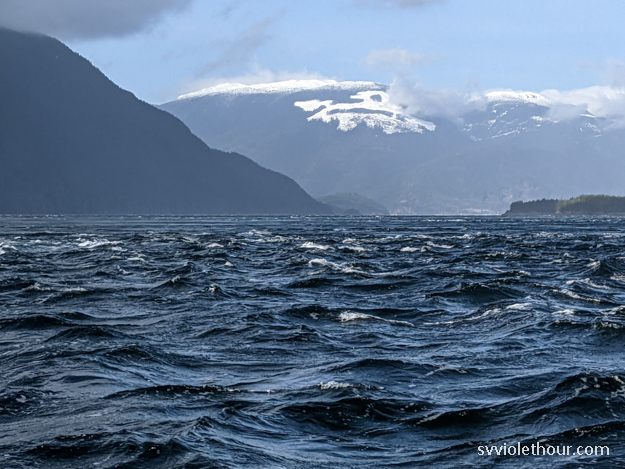
Tide rips at Ripple Shoal in Johnstone Strait
Alaska
We’re very happy to be in Southeast Alaska now and are going to spend a week in a marina in Ketchikan to dry out our very wet boat, wash all our salty clothes, get groceries, fix things that broke, and rest after a very tiring 2 1/2 weeks. It’s still the tail end of winter up here, so we’re not in a rush, but we’ll be getting out to explore the vast marine wilderness of southeast Alaska at a much slower pace soon.
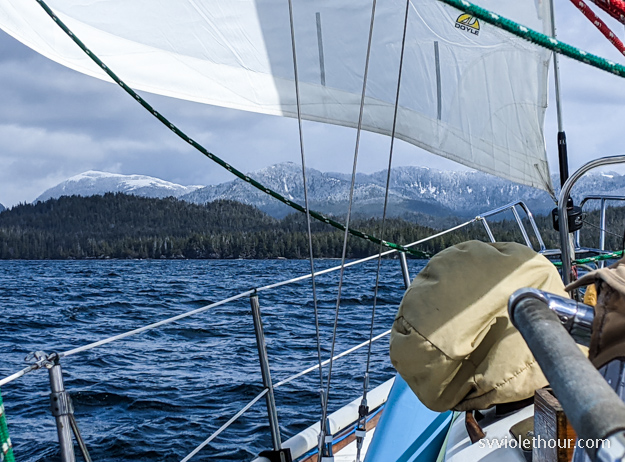

Congrats, guys! That’s some serious passage work. I expected your engine repair list to be much longer. Clearly you did a great job of preparation. I felt the dorade loss even before your “ouch.” Thanks for publishing so much of your log. It’s really helpful.
Congrats you two. We will see you up there in a few more weeks.
We’re excited to get some more boats up here! The Ketchikan harbormaster said we’re only the 4th visiting boat this year.
Impressive work, you two. It was ballsy going up that early, but it sounds like you were prepared, mostly. Are you actually setting up residence in AK, or is that what you needed to report in order to get there? Anyway, assuming you’re headed back south in the summer, your return should be a gorgeous trip. We can’t wait to make this trip ourselves, albeit a little later in the year and at a more saner pace;) Enjoy SE AK! Looking forward to reading about your time there.
Well, I’m not sure if moving residency is required in order to make the trip or not, but we looked at it as we’re moving our home to AK indefinitely. As long as Canada has no plans to reopen, we have no plans to leave Alaska.
Hi Patrick & Natalie, Congratulations on your voyage! I hope you have a fantastic summer enjoying the beautiful nature in Alaska.
Congrats Patrick.
Enjoyed the read. I learned about your blog from the Good Old Boats story on your AP conversion. Curious how the below deck AP preformed. Would a windvane have provided adequate support on your passage to Alaska? The reduction in electrical demand has me leaning towards a vane over replacing the wheel AP on my Cal 35.
18 days is an insane pace, I have been thinking 6 weeks. There has been talk of a possible border opening. Canada appears to be behind on vaccinations which is a sensible reason for delay to border crossings.
Following your passage is in my plans. I had planned for a summer 2020 360 of Vancouver Island as prep for the North to Alaska cruise. All is on temporary hold. A multi week cruise is more the focus than s 18 day dash.
Your list of repairs was fairly minimal. You must have did more in the way of preparation then let on.
Enjoy your exploration of SE Alaska. I look forward to you sharing further experiences.
Our autopilot has been great. I don’t think a windvane would’ve been very useful on our transit or in AK. We use the AP a fair amount while motoring, so an electric would still be necessary for that. And when sailing we’re typically using it in conditions that are very challenging for a windvane.
We did do a lot of boat projects and prep over the winter.
Thanks for the comment.